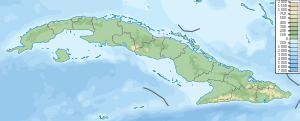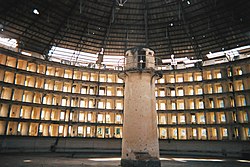Isla de la Juventud
| Isla de la Juventud | ||
|---|---|---|
| Satellite image of the island | ||
| Waters | Gulf of Batabanó / Caribbean Sea | |
| Archipelago | Canarreos Archipelago | |
| Geographical location | 21 ° 45 ′ N , 82 ° 51 ′ W | |
|
|
||
| length | 70 km | |
| width | 55 km | |
| surface | 2204 km² | |
| Highest elevation | Loma La Cañada 310 m |
|
| Residents | 84,751 (2012) | |
| main place | Nueva Gerona | |
| Isla de Pinos on the map from 1837 | ||
The Isla de la Juventud (Eng. "Island of Youth"; until 1978 Isla de Pinos , Eng. "Pine Island") is Cuba 's largest secondary island and the sixth largest island in the Caribbean with an area of 2204 km² . It is not a separate province, but is treated as a special administrative area ( Municipio especial ). The island is located in the Gulf of Batabanó on the Caribbean side of Cuba and is part of the Archipiélago de los Canarreos . Nueva Gerona is the main town and with 69,976 inhabitants it is also the largest city on the island (2012 census).
In addition to the capital Nueva Gerona, the island has eight other urban (Santa Fe, La Demajagüa, Patria, Delio Chacón, La Reforma, Argelia, Atanagildo and La Victoria) and 49 rural settlements.
history
Archaeological finds indicate that the Guanahatabey Indians were the first settlement group, who presumably lived as nomads in caves near the coast. Later the island was populated by the Ciboney from Venezuela and (from around the 3rd century AD) the Taíno from neighboring Jamaica . The natives called the island Siguanea until Christopher Columbus landed here on his second trip to the New World in June 1494 and gave it the name La Evangelista . From the 16th to 18th centuries, the island was a refuge for many pirates such as Francis Drake , John Hawkins , Thomas Baskerville and Henry Morgan . The activities on the island then called Parrot Island are said to have inspired Robert Louis Stevenson to write his world-famous novel Treasure Island .
Later the island was called Isla de Pinos (pine island , sometimes incorrectly translated as spruce island or pine island ) and was notorious as a prison island under both the Batista and Castro governments. Among other things, José Martí sat here in the 19th century , and later the Moncadistas around Fidel Castro from 1953 to 1955 . Also during the guerrilla struggle, many revolutionaries, especially those from the " July 26th Movement ", were brought to the island. B. Armando Hart . From 1959 Castro had numerous former combatants and even former prisoners from the Batista era locked up here, including B. Mario Chanes de Armas , Huber Matos and Eloy Gutiérrez Menoyo . The ruins of the Presidio Modelo prison, which was built in 1928 and where up to 6,000 prisoners were held in five round buildings, can still be viewed today . It was closed in 1967.
After the Cuban Revolution , agricultural development should be promoted on the island. For this purpose, many thousands of young people, mainly from third world countries , came to the Isla to study and work , which explains the symbolic name change to Jugendinsel (1978). Most of the numerous boarding schools are now orphaned.
The island became known among other things as treasure, pirate or gold island.
A Cuban who speaks of the Isla means almost exclusively the youth island and not his large home island .
Web links
Individual evidence
- ↑ Archive link ( Memento from June 20, 2009 in the Internet Archive )
- ↑ Sailing Directions (enroute), Pub. 147, 5.39 Isla de la Juventud (page 75) (PDF; 4.6 MB)
- ↑ Isla de la Juventud - Cuba - Geografía - Población



